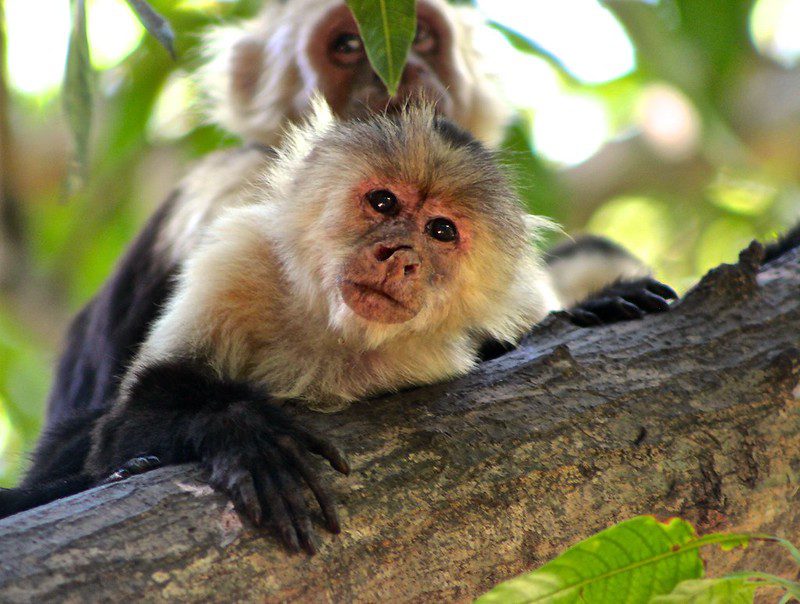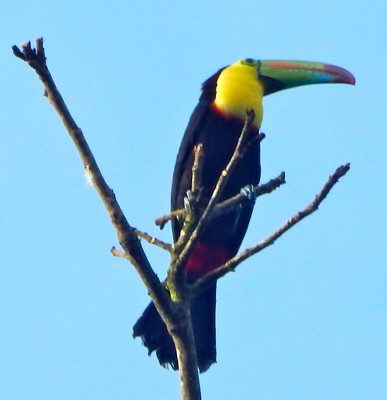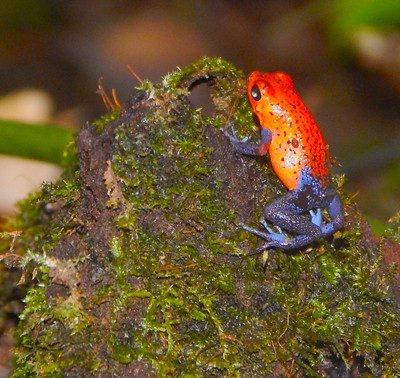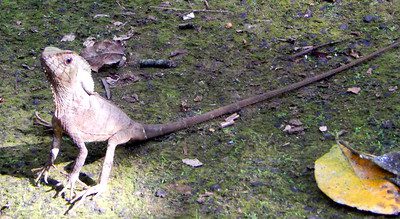The tropics are weird

Camera. Check.
Rain Poncho. Check.
Industrial strength mosquito repellent. Check.
Anti-itch ointment. Check.
High-powered flashlight for nighttime exploration. Check.
Rice for sucking out moisture trapped in cell phone. Check.
These are among the items you’ll likely find on a packing list for Furman’s Costa Rica Tropical Ecology May Experience (MayX for short). Folks in the Biology department might also add a couple of intangibles: a sense of humor, and a steely willingness to step out of one’s comfort zone.
Following exams in May this year, 14 students and Drs. Joe Pollard and John Quinn of the Biology Department embarked on the three-week excursion, a mini study away which has taken place every other year at Furman since 1990. The cadre went in with high expectations; and according to sources close to the adventure, did not come away disappointed.
“We were separated from everybody and everything except nature for three weeks,” says intrepid Dainee Gibson ’16. “It was hard to believe it was real at times. You would see toucans with their brightly colored bills fly over, brilliant frogs and birds . . . and huge bugs.”
The experience is made possible through the Organization for Tropical Studies in Costa Rica, which oversees field stations in Palo Verde and La Selva among others. So, in addition to 10-mile hikes through dense forest, students were able to plug into the OTS network of educational sites and research. “For students it’s fantastic because they get to see ongoing research—things you read about in textbooks,” says Quinn, who this year logged his first Costa Rica MayX.

Keel billed toucan by Matt Giordano ’15.
Costa Rica occupies only .03 percent of the planet’s real estate, yet holds six percent of the world’s biodiversity—a reality that makes the country a perfect living laboratory for researchers studying ecosystems in tropical rain forests, tropical dry forests and mountain cloud forests.
Costa Rica occupies only .03 percent of the planet’s real estate, yet holds six percent of the world’s biodiversity—a reality that makes the country a perfect living laboratory for researchers studying ecosystems in tropical rain forests, tropical dry forests, and mountain cloud forests.
Having notched five trips to the tropical land bridge, Pollard says classroom learning can only go so far in explaining a natural ecosystem. “As a field ecologist, I firmly believe it needs to be experienced firsthand. The tropics are immensely important in the biodiversity and function of our planet, yet they are in great peril. So giving Furman students a chance to really understand the tropics is a very meaningful learning opportunity.”

Strawberry poison dart frog. Photo by Matt Giordano ’15.
Color-splashed poison dart frogs, reptiles that look like they skittered out of “Jurassic Park,” peccaries (pig-like creatures with bristly fur), countless winged fowl (and bats), white-faced capuchin and spider monkeys, and the piercing call of the howler monkey are just a handful of the animals encountered.
Especially exciting for birder Dr. Quinn was being amongst the nearly 1,000 different bird species in the region. And in some locations, the concentration of the strawberry poison dart frog was one per square meter.
As for the buzzing, creeping, crawling varieties of animals—those took some getting used to. Gibson says, despite enduring “skies black with mosquitos” at times, and the requisite bites, “You got desensitized very quickly.” Nestled in the heart of a national park, the field station at Palo Verde was the most rustic of the venues visited. Quinn says sleeping in mosquito nets and shaking out pillows before bed to check for scorpions had a way of setting the baseline for the trip.
Overall, the group was too awed by the beauty of lush tropics to be trifled with by a few bugs. The research, journaling, and blogging requirements for the trip also kept students focused on the tasks at hand. A “legit class,” (as posted by Jason Pecorella ’16) the Tropical Ecology MayX concluded with a final. Students conducted field and laboratory research projects designed by professors and independently by the students themselves.
As for highlights of the trip, Sami Alkoutami ’16 says the experience was so amazing that picking a favorite moment is as hard as naming a favorite book. He says a 4 a.m. hike to view a sunrise in Palo Verde was unforgettable, as was bonding with newfound friends on a lagoon boardwalk, just listening to the nighttime sounds. Hiking four hours in a pelting downpour (sans rain jacket) was another memorable moment, made even more so by Dr. Quinn’s impromptu puddle jumping and splashing episode. “It was good to see professors are kids at heart, just like us,” says Alkoutami.
Gibson says the cloud forest at Monteverde has stuck with her. “That was really cool because it looked so different from anything else we’ve ever experienced. It was almost alien . . . ferns taller than this room,” she says, gesturing to the ceiling. Quinn adds that the “rain shadow effect” witnessed at Monteverde “is a great example of something we talk about in class, but to walk out and see it is pretty unique.”
For faculty, trip success is often measured by what doesn’t happen. Granted, after 12 iterations, the trip runs like a well-oiled machine. Still, Pollard was pleased with the lack of drama—“No close shaves, major illnesses, or even missed travel connections.” And even better, no close brushes with Costa Rica’s most deadly viper, the fer-de-lance. “I always tell students we want to see every snake in the forest, because it’s the snake you didn’t see that bites you,” says Pollard.
Having averted most dangers and illnesses, students were free to avail themselves to a fair amount of downtime. Zip-lining through the forest canopy, Tarzan swinging, ocean kayaking, frolicking in waterfalls, snorkeling among multi-colored fish, hanging out by the pristine, sugar-white beaches of Manuel Antonio, playing soccer, and consuming very fresh food and exotic juices were among the extracurricular activities outside of serious research and observation.
And when it might seem that nothing else could equal the sheer beauty of Costa Rica’s natural world, there’s another aspect of the experience that just might, says Audrey Heldreth ’15 in her blog. “While the adventures were obviously incredible, there is no doubt in my mind that the reason our trip to Costa Rica was unforgettable was because of the people who were on it. All of the bus rides, humidity filled hikes, and anything in between was made infinitely more enjoyable with our group dynamics.”

No worse for the wear, the casquehead lizard survived the encounter with Heldreth. Photo by Matt Giordano ’15.
Heldreth, by the way, was rudely interrupted on a hike by a two-foot-long casquehead lizard that decided to hitch a ride on her leg. Apparently needing a better view, it climbed across her shoulders, then up to her head. Petrified by Heldreth’s screams and gyrations, the lizard remained frozen there for a while. Good times.
Shaking off the lizard incident, Heldreth had this to say in her closing blog about the “dysfunctional family” the group had become. “If there’s any way to wrap this up, it is to say thank you to all my classmates, Dr. Pollard, and Dr. Quinn. The tropics are weird and so are y’all, and I wouldn’t have had it any other way.”
Heldreth’s tender honesty is echoed by other MayXers. With the trip open to non-biology majors, Gibson says she didn’t know anyone going in, but now talks daily with members of her “weird little family.”
Alkoutami says hats off to Drs. Pollard and Quinn for putting together what he calls a “smoothie of very odd people.” He says, “To work three weeks with 14 very different people in an environment that pushed us to our limits, and some of us past our limits, was incredible. I think that changed my life.”
Alkoutami says hats off to Drs. Pollard and Quinn for putting together what he calls a “smoothie of very odd people.” He says, “To work three weeks with 14 very different people in an environment that pushed us to our limits, and some of us past our limits, was incredible. I think that changed my life.”
See more photos from the May Experience class here.
For a related Costa Rica story, click this link.